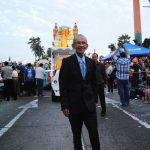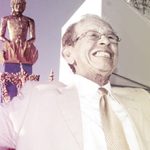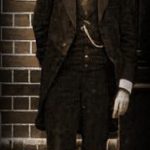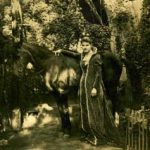RIGOBERTO LEWIS AND THE CARNIVAL
The Mazatlan people recognize in the carnival parade one of the central moments of the celebration, as a fundamental act that summarizes the totality of the elements that make up the party.
From 1960 on, the talent of Dr. Rigoberto Lewis prevailed in the design of allegorical cars, with their precious forms, of almost architectural moldings loaded with a singular kind of decorative baroque, very attractive to the popular taste.
Rigo Lewis was a key character to take the carnival of Mazatlan from the level of a regional festival. The television, personified in the producer and driver Raul Velasco, offered an opportunity that the creator took advantage of to unfold his wit in sizes and colors not explored before in the Mazatlan carnivals, even national; and, in this way, helped to get our party the category of “International Carnival of Mazatlan”. Since then, the conviction that our carnival is among the best known in the world has been forged.
The permanence of Rigo Lewis in the making of the floats and much of the rest of the cars, almost uninterrupted for 55 years, speak of the enormous social recognition he enjoyed thanks to the almost unanimous acceptance of his ephemeral works in popular taste.
The applause that year after year the public offered him to the step of the float of the queen of the carnival is incontrovertible proof of the generalized appreciation for his artistic work. Today, his legacy is unquestionable: an unrepeatable style that made time and that is considered as our own carnival.
He said that he had begun to get involved in these tasks, almost as a mischief, since his high school years. In 1956 he had his first approach with Engineer Leopoldo Reyes Ruiz “Pepegrillo”, who had just been released as Director of the Carnival, after having presented an allegory during the student parade on November 20. By 1960, Lewis had been assigned the construction of the Royal Trolley, a job he would specialize in the future.
With the passage of time, his ingenuity led him to introduce significant changes in the design of rolling allegories, which were from the adaptation of materials and colors; in the location of the sovereign according to her role, to try to achieve the greatest possible visual impact in the eyes of the carnival subjects; the transformation of bases or platforms to gain grandiloquence through the profusion of ornaments; and, the use of lighting to create games of shadows and striking feicidal luminosities.
In each participation a new challenge was forged. He could repeat the thematic reference in the design of the floats, yes, never from one year to the next; but, it always surprised the public with notable variations that made each car different.
The price of his works became the subject of Carnival mythology. The estimated value that the public attributed to him and the possible public claims of the creator for debts linked to his hiring, promoted him an image of enrichment that contrasted with his standard of living and his way of working. He was an amateur to collect antiques of artistic value; but his devotion to the carnival led him to invest a good part of the economic resources he obtained throughout his life in gathering an important documentary, photographic and material collection about our maximum party, which he hoped to deliver for the formation of the Carnival Museum; respect to which his heirs must determine their destiny.
Rigoberto Lewis left on January 9 and was fired, accompanied by the tambora and to the rhythm of “Los Papaquis”, because he so requested and to highlight his significant contributions to the history of the Mazatlan carnival.
ANTONIO HAAS ESPINOZA DE LOS MONTEROS
Writer, dilettante
In Mazatlan, on October 29, 1923, Antonio Haas Espinoza de los Monteros was born, a singular character who gave luster to the local culture and who, from its rostrum at the national level, helped to consolidate some angles of the business vision on cultural public policies , educational, agricultural and the party system, fundamentally.
He developed on his own initiative many facets throughout his life, without formally preparing for them and, in almost all, always managed to stand out. He was a teacher at the Preparatory School of Mazatlan, during the last years of the administration of the Sociedad Procultura Regional; He was also a painter by the hand of Margarita “La Nana” Ramírez; as well as a musician for his friendship with Cole Porter and others; as well as theater director in the Prepa and very successful musical sessions among the wealthy classes, some time later.
As a cultural promoter, Haas was noted for its impetus to the fine arts in Mazatlan and Sinaloa. He did not tell it, but Cataño Michelena took up a familiar anecdote from the writer who saw full-fledged the origin of that eagerness to inculcate and disseminate the artistic innovations in the port.
With this innovative spirit he undertook the task of modernizing the Floral Games of Mazatlan, he began to mount the ceremonies of coronation and delivery of “the natural flower” with more theatrical airs than the typical ceremonial events, similar to the civil and school ones that until then they got used to it. He also convinced Rodolfo Álvarez Fárber and Raúl Rico Mendiola, among others, to leave behind the poetry contest and replace it with the Mazatlán Prize for Literature of national scope. Only for a brief period did he impose his idea of omitting the celebration of the poetic contest; then, he accepted the coexistence between both awards in the same ceremony. Later, the failure of the prize to Carlos Fuentes in 1972 put at risk the survival of the Mazatlan of Literature, managed to rescue it eleven years later, with the help of Raúl Rico González.
On the other hand, in his role as a writer, without being a journalist himself, in the journalistic sense of the term, Haas received the National Prize for Journalism in 1991, for his editorial contributions in the newspaper Excelsior and the weekly Siempre; the corresponding one at the state level was granted to him in 1995, in response to his career as a columnist in the newspapers El Sol del Pacífico, Noroeste and El Debate.
His death occurred on October 14, 2007. Currently, his house was remodeled and will function as an enclosure dedicated to the Carnival Museum, according to the project of the Ministry of Tourism of the State Government, with the support of the municipal government.
MARTINIANO CARVAJAL
Medical, political and intellectual.
Born on January 2, 1866, in a cuartería located on Camichín Street, which today bears his name, Martiniano Carvajal was an exceptional man, endowed with an outstanding intelligence, to such a degree that his contemporaries qualified him as wise and extremely kind. On this illustrious Mazatlan character, El Diario de Jalisco said in his time: “He has a privileged talent, combined with a foolproof application and an irreproachable behavior. He has given a vast wealth of illustration not only to medicine, which, as is natural, has been preferentially consecrated, but to many other subjects. ”
In the political sphere he was councilor, President of the City Council and Prefect of the District. On the occasion of the first elections for governor of the State, after the triumph of the Maderista revolution, he was proposed as a candidate for that office, however he declined.
Martiniano Carvajal must also be remembered as one of the main promoters of modern carnivals in our port. Thanks to him and to other Mazatlecos of his generation, it was possible to modify the flour sets, which characterized our carnestolendas, as well as the implantation of the Italian modality of confetti and serpentine, the parades of decorated cars and the introduction of the Burning of Evil Humor, the Saturdays prior to the dates of the celebration, because this last event was held for the first time in 1904, after the successful struggle to banish the bubonic plague, which prevented the Carnival celebration of 1903.
In the biomedical area, his family keeps unpublished on hygiene and physiology, nervous diseases and, perhaps the most interesting for his time, diseases of the coast. His Report of the Health Committee on the Bubonic Plague is the formal memory of that tragic Mazatlan event, which took place between the end of 1902 and the beginning of 1903.
The illustrious Mazatleco died in Mexico City on July 10, 1935.
Leopoldo Reyes Ruiz “Pepegrillo”
Traditionalist carnival
At age 37, Reyes Ruiz had, for the first time, the opportunity to lead the organization of the Carnival, in 1956. Without a doubt, that was a success because it marked the beginning of a new era for the Mazatlan festivities, which had entered into a pothole of little more than 10 years, after the tragedy of the Carnival Monday of 1944, when during the official carnival dance, the State Governor, Colonel Rodolfo T. Loaiza, was assassinated.
Reyes Ruiz owes a successful adaptation of the Mazatlan carnivals to the conditions of his time. He proposed and managed to introduce important innovations that changed the way of organizing and celebrating the Mazatlan carnival. He renewed it and with it he placed it again in the center of Mazatlan life. From the carnivals of 1956, 1957, 1961 to 1965, which he himself baptized as the Carnival of Pepegrillo, the Mazatlan carnivals were modernized.
To revive the pomposity of the festivities, Reyes Ruiz turned to the story and, perhaps in an improvised but accurate way, to the use of the media as a marketing tool. In the main newspaper of the time, El Sol del Pacífico, the then Director of Carnival created a journalistic column to promote the celebration in advance. From that journalistic forum, it was weaving a suitable atmosphere of expectation to awaken interest in the population about the organizational activities of the Carnival.
It was also important that the Carnival organization be distinguished from those that preceded it. The engineer Reyes Ruiz and his collaborators were incubating a new organizational order, more in line with the social demands of professional attention to all activities, including recreational activities such as Carnival. In benefit of the re-launch of the Carnival by its fueros, constituted the participation of the queens in other activities of community interest, if before “liberated” inmates, now inaugurate public works, as the case of the opening and paving of a section of the Paseo Claussen .
Carnival parades ceased to be the sum of improvised cars for the purpose of commercial propaganda, films and various businesses, presided over by the royal carriage and the Floral Games, when the Queen was not the same as Carnival, and Ambassador cars. The aspiration to standardize the style of the rolling allegories was taken to the extreme of giving a theme name to the whole ensemble, the carnival themes.
The carnival began to recover, under the influence of new forms of promotion and organization, its central role in the popular mood. The strength of the resurrection was such that during the Carnival of 1957 the first dispute arose, a true mercantile war, between the main companies of the branch in the town, by an unusual growth of the market of beer consumers at that time. After those two years, Pepegrillo left the driving of the party. He returned in 1961 and organized five carnivals in a row. In that period, from 1961 to 1965, the renewal character that had been printed to those of 1956 and 1957 was accentuated. Permanent offices were opened for the organization of the party, something that did not exist before; Workshops for the construction of allegorical cars and street ornaments were mounted, which resulted in the professionalization, as an innovative phenomenon, in the Mazatlan carnivals.
In economic matters, the parties continued to depend on government support, and Reyes Ruiz always argued that the municipalities of his time did not finance “their carnivals”, but admitted that the state government was used for sponsorship.
Totally removed from the organization of carnivals, under the quality of chronicler, at the end of the last century, Reyes Ruiz wanted to lead an epic crusade in favor of what he called traditional carnivals. He wanted to remember his carnivals as family parties and even the “beer war” of his time tried to explain it as a bohemian anecdote, and he did not accept it as the current “drunkenness”. When he was already in his 80s, Reyes Ruiz made an effort to forge a public image as a carnival stranger to excesses and waste. He died on April 18, 2006.
Winifred Farmer
First queen of the Mazatlan Carnival.
It was the year of 1900 and the third edition of Mazatlan tinsel carnival was in preparation. The organizing committee had been installed, presided by Don Natividad González, the vice president was Don Carlos L. Volquardsen, and as secretary, Adolfo O ‘Ryan. On that occasion, a special commission was formed, charged with the high and delicate mission of offering the crown of the carnivalesque kingdom to the future consort of His Majesty, the King. The Mail of the Evening celebrated the event in a note, which entitled “The Carnival of 1900 will receive a Queen”; The chosen one was Winifred Farmer, who was then 17 years old, described in the chronicles as very helpful and affectionate.
Data obtained from the federal census office of the United States allow us to locate his birth in 1882. According to Jesús Ernesto Gómez Rubio, she was born in Garland, Maine. He must have arrived very small in Mazatlan with his family. Here he lived for more than 20 years, but it was not until 1917 that he returned to his home country. Surely his studies were conducted in Mazatlan, because he spoke Spanish perfectly, they say. Here he got married and had a daughter.
From her participation in the carnival celebrations of 1900, the one that was recognized as the first sovereign remembered with nostalgia, many years later, that she made two costumes, the reception and the riding. The dressmaker in charge of both was Mrs. Delfina Perla. In the salon portraits and in the photo of the dance at the Casino, taken on Carnival Sunday, he appeared with the suit, which, according to the press, was Catalina de Médici style. That same dress was worn during the reception walk of the kings and in the official parade of decorated cars and carnival Sunday extras.
In another photo of her reign, she is on horseback and wears a purple velvet brocade riding dress with white chevrons. In his memoirs, Jesús Ernesto Gómez Rubio stated that the clothing was chosen by Winnie from a publication, which showed Queen Wilhelmina of Holland reviewing the troop on a steed, and thus wanted to pose as a sovereign. Regarding the steed, the same author, to highlight the bold personality of Winnie, says he rode it despite having just knocked down his dad.
The double attire was due to Winnie, in her capacity as Queen, wanted to participate on horseback in the ride of riders, comparsas, bicycles, air cars, cars and other mobile phones, which the committee scheduled to be held on Tuesday of Carnival, from three in the afternoon.
In 1956, Winnie was in Mazatlan during Carnival, and recalled: “I rode on horseback, escorted by several young people, including Bailey and Guillermo Haas.” The unusualness of this fact led to the photo being shared with his steed profusely. With that photograph, the legend of the queen was born who paraded on horseback, who managed to highlight the determined character of the young pioneer, who risked being the first woman to preside over the party, even if she represented the role of the consort of the main character of the carnival at that time, His Majesty, the King, but the sovereign riding costume, a reminder of his carnival adventure, kept it as one of the most important moments of his life, a treasured treasure.
Héctor Díaz Valdez
Social journalist, organizer of Carnivals and beauty pageants.
There are anecdotes that mark; they say that Hector Diaz told that his had happened in 1936, when his mother took him to visit the house of the Boner family, whose daughter was the Carnival Queen of that year, and when they arrived, Adela Boner was dressed in her costume Real, she took him in her arms and made him love. He was so impressed that all his life he wanted to be involved in the festivities that that woman represented and near the trappings she was wearing.
For 20 years, Héctor Díaz directed the organization of Buenos Aires carnivals. From 1968 to 1989, he was in charge, almost uninterruptedly, of the tasks of directing the maximum party in Mazatlan, only in 1982 and 1987 he did not lead the organization. Its presence in the festivals corresponds to that in which the internationalization of carnivals is achieved. If he boasted of anything, it was precisely that he had succeeded. His career at the front had begun with the support of Bernardo Sánchez Osuna, apparently a relative of his, who, as Municipal President, managed to place him at the head of the festivities during the last year of his administrative management.
Díaz was born in 1933, in Concordia, Sinaloa. If we attend to the date of the foundational anecdote of his passion for parties and reigns, from a very young age he lived in Mazatlan. He did not have the opportunity to pursue higher education. Apparently, his first job was in a nursery where, in addition to taking care of the plants, he began to make flower arrangements. Then, he was hired as a shop window decorator. Later, he would be a promoter of dances at the Club Deportivo Muralla. Finally, he would own his own store of decorations and floral arrangements.
As a carnival of heart that was, each year joined the committee of any of the candidates for Queen of Carnival. They say that in that quality of promoter of aspirants to the reign he was successful, because most of the girls he supported achieved the crown. He also ventured into a small group of amateur theater, which met at the Morelos School. With these rudiments, he was able to organize and successfully participate in dance troupes and floats for Carnival parades. In a natural way, due to the areas in which he developed and the public relations that he increased, he was able to develop an important career as a chronicler of social events and, of course, as a columnist promoting carnivals. The Pacific Sun was the first to publish its notes and columns.
Héctor Díaz, hand in hand with Rigo Lewis and his colorful floats, took the Mazatlan carnival to the level of a regional festival, thanks to his rapprochement with the producer and television host Raúl Velasco. Díaz Valdés consecrated his achievements in the organization of the carnivals, to its transmission by television and to leave a mark of the change that it meant, he named the party “Carnaval Internacional de Mazatlán”, in commemoration of that step. Since then, the chauvinist conviction has been forged that our carnival is among the best known in the world.
Those were the times when tourism rooted their interests in Mazatlan and, under an authoritarian regime like the one lived then, carnival costs were not a relevant issue, especially if they were justified in order to consolidate the port as a tourist destination of World class.
With Velasco, another opportunity came for Héctor Díaz, the one to organize beauty contests in a big way. In 1970, with the triumph in the Miss Mexico contest of Libya Zulema López Montemayor, whom he had brought from Guasave to reign in the Buenos Aires carnival, the boom season of this type of contests began. Hector Díaz not only applied it for the selection of carnival queens, but he extended it to all of Sinaloa with the promotion of the contest to name the local representative in the national event. Several times the triumph of a Sinaloan was repeated under her baton, which became a sign of state pride.
At the end of the decade of the 80s of the last century concluded the step for the organization of the parties of “Mr. Carnival “, as they also nicknamed him. Hector Díaz died in 1997 and, for the first time, the carnival hymn, “Los Papaquis,” was heard at a funeral ceremony in our port.
* Texts: Enrique Vega Ayala, Chronicler of Mazatlan






